World Heritage Site
A world Heritage Site is a landmark or area with legal protection by an international convention administered by the United Nations Education, Scientific and Cultural Organization (UNESCO).
These sites are important places of cultural or natural heritage as described in the UNESCO world heritage Convention, Established in 1972.
United Nations Education, Scientific, and Cultural Organization (UNESCO) were founded in 1945 to develop the ‘intellectual and moral solidarity of mankind, Located in Paris, France.
Important Facts about World Heritage Sites
The program began with the “Convention Concerning the Protection of the World’s Cultural and Natural Heritage” which was adopted by the General Conference of UNESCO on 16 November 1972.
- The world heritage site list is maintained by the international World Heritage Program administered by the UNESCO World Heritage Committee.
- The World Heritage Committee has divided the world into five geographic zones which it calls regions: Africa, Arab states, Asia and the Pacific, Europe and North America, and Latin America and the Caribbean.
Zones of World Heritage sites
World Heritage Committee’s five zones with the number of sites are given in the table:
| Zone | Number of sites |
| Africa | 96 |
| Arab states | 86 |
| Asia and the Pacific | 268 |
| Europe and North America | 529 |
| Latin America and the Caribbean. | 141 |
- The first World Heritage Site on the list is Galapagos Island.
- Countries with the largest number of sites: China and Italy both with 55 entries
WORLD Heritage sites in India
In India the First sites on the list were the Ajanta Caves, Ellora Caves, Agra Fort, and Taj Mahal, all these were inscribed in the 1983 session.
The latest site inscribed was Jaipur City, Rajasthan in 2019, and after it, in 2021 at the latest Kakatiya Rudreshwara (Ramappa) Temple, Telangana, and Dholavira: a Harappan City in the State of Gujarat, is added.
At present there are 40 World Heritage Sites in India, out of these, 32 are cultural, 7 are natural, and 1 is mixed (meeting both cultural and natural criteria).
Seven Natural Heritage sites of India
Out of forty, the seven natural heritage sites are as follows:
- Great Himalayan National Park Conservation Area (2014)
- Kaziranga National Park (1985)
- Koeladeo National Park (1985)
- Manas Wild Life Sanctuary (1985)
- Nanda Devi and Valley of Flowers National Parks (1988,2005)
- Sundarbans National Park (1987)
- Western Ghats (2012)
Mixed Type heritage site in India
There is one mixed type of world heritage site in India:
- Khangchendzonga National Park (2016)
List of World Heritage Sites in India
1. Agra Fort (1983): Uttar Pradesh India
- Near the gardens of the Taj Mahal stands the important 16th-century Mughal monument known as the Red Fort of Agra.
- This powerful fortress of red sandstone encompasses, within its 2.5-km-long enclosure walls, the imperial city of the Mughal rulers.
- It is located on the right bank of the Yamuna river. It comprises many fairy-tale palaces, such as the Jahangir Palace and the Khas Mahal, built by Shah Jahan; audience halls, such as the Diwan-i-Khas; and two very beautiful mosques.

Agra fort
2. Ajanta Caves (1983): Maharastra
- The first Buddhist cave monuments at Ajanta date from the 2nd and 1st centuries B.C. During the Gupta period (5th and 6th centuries A.D.), many more richly decorated caves were added to the original group.
- The paintings and sculptures of Ajanta, considered masterpieces of Buddhist religious art, have had a considerable artistic influence

Ajanta Caves
3. Ellora Caves (1983): Maharastra
- These 34 monasteries and temples, extending over more than 2 km, were dug side by side in the wall of a high basalt cliff, near Aurangabad, in Maharashtra.
- Ellora, with its uninterrupted sequence of monuments dating from A.D. 600 to 1000, brings the civilization of ancient India to life.
- Not only is the Ellora complex a unique artistic creation and a technological exploit, with its sanctuaries devoted to Buddhism, Hinduism, and Jainism, it illustrates the spirit of tolerance that was characteristic of ancient India.

Ellora caves
4. Taj Mahal (1983): Agra Uttar Pradesh
- An immense mausoleum of white marble, built-in Agra between 1631 and 1648 by order of the Mughal emperor Shah Jahan in memory of his favorite wife, the Taj Mahal is the jewel of Muslim art in India and one of the universally admired masterpieces of the world’s heritage.
- The Taj Mahal is located on the right bank of the Yamuna River in a vast Mughal garden that encompasses nearly 17 hectares, in the Agra District in Uttar Pradesh.
- For its construction, masons, stone-cutters, inlayers, carvers, painters, calligraphers, dome builders, and other artisans were requisitioned from the whole of the empire and also from Central Asia and Iran. Ustad-Ahmad Lahori was the main architect of the Taj Mahal.
- Taj Mahal represents the finest architectural and artistic achievement through perfect harmony and excellent craftsmanship in a whole range of Indo-Islamic sepulchral architecture.

Taj Mahal
5. Sun Temple Konarak (1984): Puri, Odisha
- On the shores of the Bay of Bengal, bathed in the rays of the rising sun, the temple at Konarak is a monumental representation of the sun god Surya’s chariot; its 24 wheels are decorated with symbolic designs and it is led by a team of six horses. Built-in the 13th century, it is one of India’s most famous Brahman sanctuaries.
- It is an outstanding testimony to the 13th-century kingdom of Orissa and a monumental example of the personification of divinity, thus forming an invaluable link in the history of the diffusion of the cult of Surya, the Sun God.
- The Sun Temple is the culmination of Kalingan temple architecture, with all its defining elements in complete and perfect form
- The Sun Temple is an exceptional testimony, in physical form, to the 13th-century Hindu Kingdom of Orissa, under the reign of Narasimha Deva I (AD 1238-1264).

Konark Sun Temple
6. Group of Monuments at Mahabalipuram (1984): Tamil Nadu
- This group of sanctuaries, founded by the Pallava kings, was carved out of rock along the Coromandel coast in the 7th and 8th centuries.
- It is known especially for its rathas (temples in the form of chariots), mandapas (cave sanctuaries), giant open-air reliefs such as the famous ‘Descent of the Ganges’, and the temple of Rivage, with thousands of sculptures to the glory of Shiva.
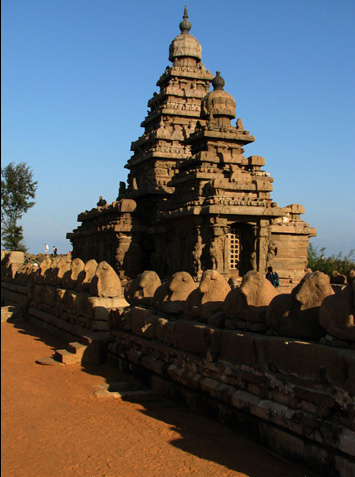
Shore Temple
7. Kaziranga National Park (1985): In Assam
- this park is one of the last areas in eastern India undisturbed by a human presence.
- It is inhabited by the world’s largest population of one-horned rhinoceroses, as well as many mammals, including tigers, elephants, panthers and bears, and thousands of birds.

Kaziranga National Park
8. Manas Wildlife sanctuary (1985): Assam
- On the Slope of the foothills of the Himalayas, where wooded hills give way to alluvial grasslands and tropical forests, the Manas sanctuary is home to a great variety of wildlife, including many endangered species, such as the tiger, pygmy hog, Indian rhinoceros, and Indian elephant.

Manas Wildlife sanctuary
9. Keoladeo National park (1985): Rajasthan
- This former duck-hunting reserve of the Maharajas is one of the major wintering areas for large numbers of aquatic birds from Afghanistan, Turkmenistan, China, and Siberia. Some 364 species of birds, including the rare Siberian crane, have been recorded in the park.

Keoladeo National park
10. The churches and convents of Goa (1986):
- It is the former capital of the Portuguese Indies – particularly the Church of Bom Jesus, which contains the tomb of St Francis-Xavier – illustrates the evangelization of Asia. These monuments were influential in spreading forms of Manueline, Mannerist, and Baroque art in all the countries of Asia where missions were established.
11. Khajuraho group of mountains (1986): Madhyapradesh
- The temples at Khajuraho were built during the Chandella dynasty, which reached its apogee between 950 and 1050.
- Only about 20 temples remain; they fall into three distinct groups and belong to two different religions – Hinduism and Jainism.
- They strike a perfect balance between architecture and sculpture. The Temple of Kandariya is decorated with a profusion of sculptures that are among the greatest masterpieces of Indian art.

Khajuraho group of mountains
12. Group of Monuments in Hampi (1986): Karnataka
- The austere, grandiose site of Hampi was the last capital of the last great Hindu Kingdom of Vijayanagar.
- Its fabulously rich princes built Dravidian temples and palaces which won the admiration of travelers between the 14th and 16th centuries.
- Conquered by the Deccan Muslim confederacy in 1565, the city was pillaged over a period of six months before being abandoned

Group of Monuments in Hampi
13. Fathehpur Sikri (1986): Uttarpradesh
- Built during the second half of the 16th century by Emperor Akbar, Fatehpur Sikri (the City of Victory) was the capital of the Mughal Empire for only some 10 years.
- The complex of monuments and temples, all in a uniform architectural style, includes one of the largest mosques in India, the Jama Masjid.
14. Group of Monuments of Pattadakal (1987): Pattadakal, in Karnataka
- represents the high point of eclectic art which, in the 7th and 8th centuries under the Chalukya dynasty, achieved a harmonious blend of architectural forms from northern and southern India.
- An impressive series of nine Hindu temples, as well as a Jain sanctuary, can be seen there.
- One masterpiece from the group stands out – the Temple of Virupaksha, built c. 740 by Queen Lokamahadevi to commemorate her husband’s victory over the kings from the South
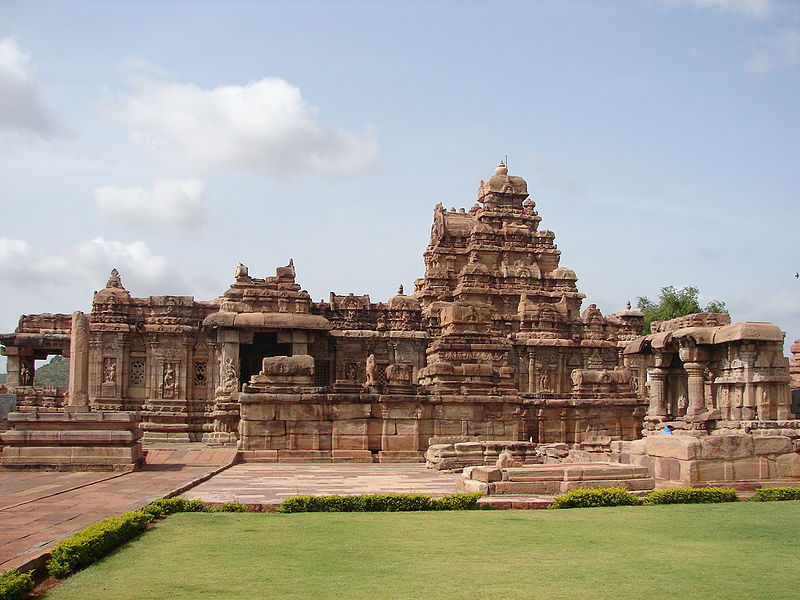
15. Elephanta Caves (1987): Maharastra
- Elephanta caves The ‘City of Caves, on an island in the Sea of Oman close to Bombay.
- It contains a collection of rock art linked to the cult of Shiva.
- Here, Indian art has found one of its most perfect expressions, particularly the huge high reliefs in the main cave.
16. Great Living Chola Temples (1987, 2004): Tamil Nadu
- The Great Living Chola Temples were built by kings of the Chola Empire, which stretched over all of south India and the neighboring islands.
- The site includes three great 11th- and 12th-century Temples: the Brihadisvara Temple at Thanjavur, the Brihadisvara Temple at Gangaikondacholisvaram, and the Airavatesvara Temple at Darasuram.
- The Temple of Gangaikondacholisvaram, built by Rajendra I, was completed in 1035.
- Its 53-m vimana (sanctum tower) has recessed corners and a graceful upward curving movement, contrasting with the straight and severe tower at Thanjavur.
- The Airavatesvara temple complex, built by Rajaraja II, at Darasuram features a 24-m vimana and a stone image of Shiva.
- The temples testify to the brilliant achievements of the Chola in architecture, sculpture, painting, and bronze casting.

17. Sundarbans National Park (1987): West Bengal
- The Sundarbans cover 10,000 km2 of land and water (more than half of it in India, the rest in Bangladesh) in the Ganges delta.
- It contains the world’s largest area of mangrove forests. A number of rare or endangered species live in the park, including tigers, aquatic mammals, birds, and reptiles.
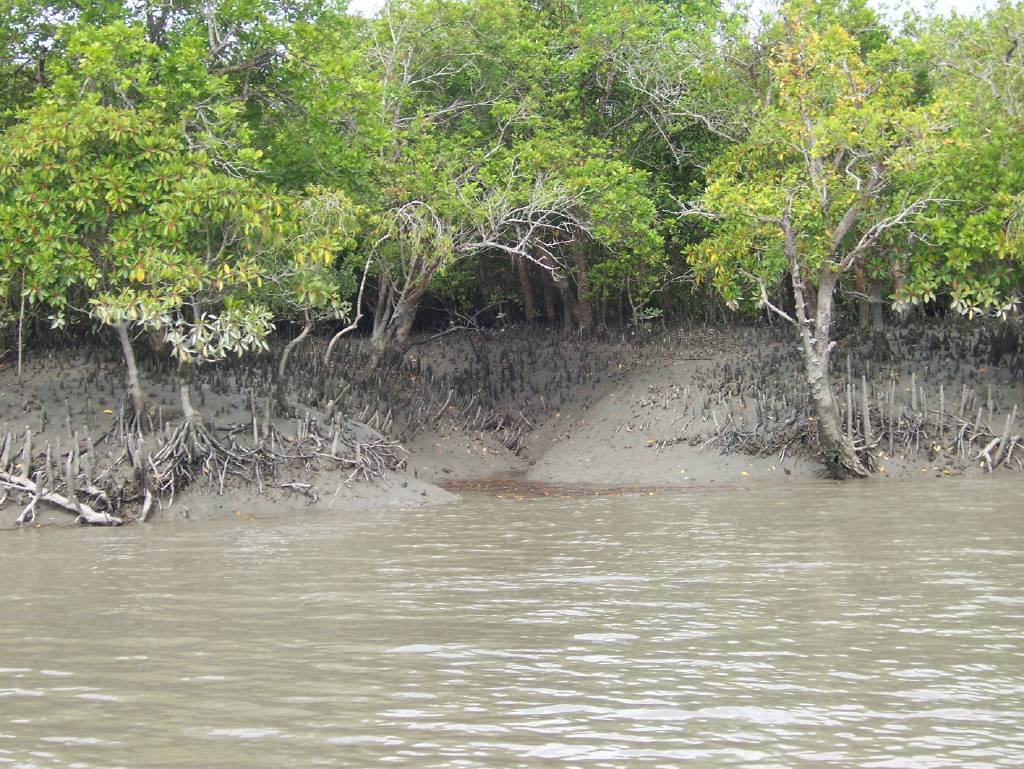
18. Nanda Devi and Valley of Flowers National Parks (1988,2005): Uttarakhand
- Nestled high in West Himalaya, India’s Valley of Flowers National Park is renowned for its meadows of endemic alpine flowers and outstanding natural beauty.
- This richly diverse area is also home to rare and endangered animals, including the Asiatic black bear, snow leopard, brown bear, and blue sheep.
- The gentle landscape of the Valley of Flowers National Park complements the rugged mountain wilderness of Nanda Devi National Park.
- Together they encompass a unique transition zone between the mountain ranges of the Zanskar and Great Himalaya, praised by mountaineers and botanists for over a century and in Hindu mythology for much longer.
19. Buddhist Monuments at Sanchi (1989): Madhya Pradesh
- On a hill overlooking the plain and about 40 km from Bhopal, the site of Sanchi comprises a group of Buddhist monuments (monolithic pillars, palaces, temples, and monasteries) all in different states of conservation most of which date back to the 2nd and 1st centuries B.C.
- It is the oldest Buddhist sanctuary in existence and was a major Buddhist center in India until the 12th century A.D.
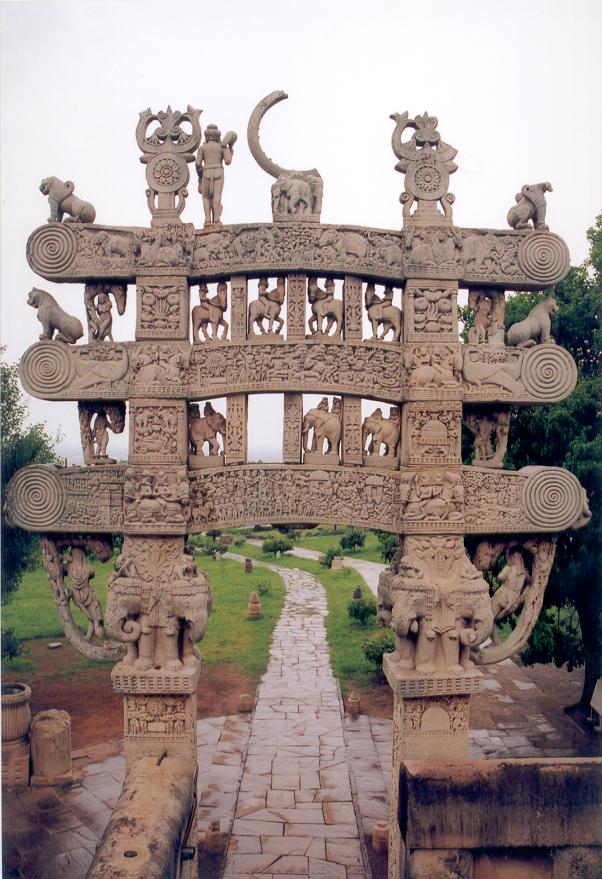
20. Humayun’s Tomb, Delhi (1993): Delhi
- This tomb, built-in 1570, is of particular cultural significance as it was the first garden-tomb on the Indian subcontinent.
- It inspired several major architectural innovations, culminating in the construction of the Taj Mahal.

21. Qutb Minar and its Monuments, Delhi (1993)
- Built-in the early 13th century a few kilometers south of Delhi, the red sandstone tower of Qutb Minar is 72.5 m high, tapering from 2.75 m in diameter at its peak to 14.32 m at its base, and alternating angular and rounded flutings.
- The surrounding archaeological area contains funerary buildings, notably the magnificent Alai-Darwaza Gate, the masterpiece of Indo-Muslim art (built in 1311), and two mosques, including the Quwwatu’l-Islam, the oldest in northern India, built of materials reused from some 20 Brahman temples.
22. Mountain Railways of India (1999,2005,2008):
- the Darjeeling Himalayan Railway was recognized first in 1999, Nilgiri Mountain Railway followed suit as an extension to the site in 2005, and the Kalka–Shimla Railway 2008 was further added as an extension
- This site includes three railways. The Darjeeling Himalayan Railway was the first and is still the most outstanding, example of a hill passenger railway. Opened in 1881, its design applies bold and ingenious engineering solutions to the problem of establishing an effective rail link across a mountainous terrain of great beauty.
- The construction of the Nilgiri Mountain Railway, a 46-km long meter-gauge single-track railway in Tamil Nadu State was first proposed in 1854, but due to the difficulty of the mountainous location, the work only started in 1891 and was completed in 1908.
- This railway, scaling an elevation of 326 m to 2,203 m, represented the latest technology of the time.
- The Kalka Shimla Railway, a 96-km long, single-track working rail link built in the mid-19th century to provide a service to the highland town of Shimla is emblematic of the technical and material efforts to disenclave mountain populations through the railway. All three railways are still fully operational
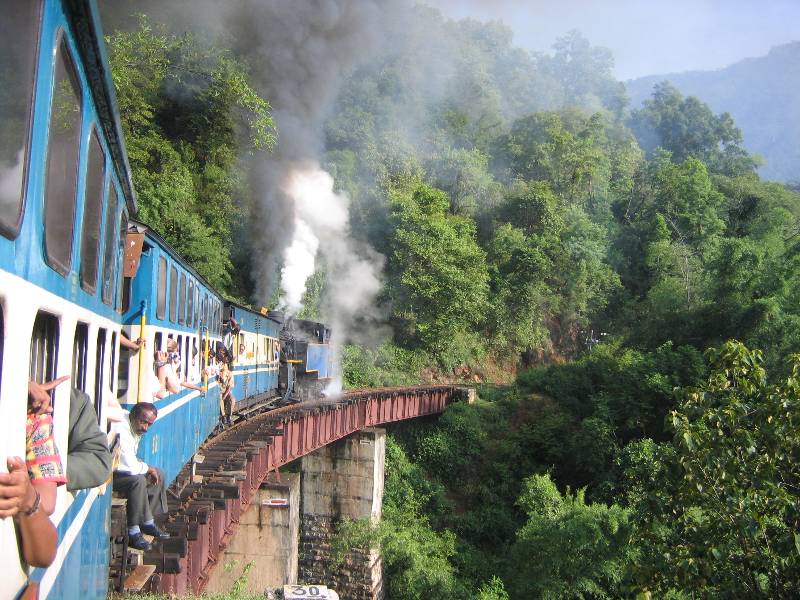
23. Mahabodhi Temple Complex at Bodh Gaya (2002): Bihar
- The Mahabodhi Temple Complex is one of the four holy sites related to the life of the Lord Buddha, and particularly to the attainment of Enlightenment.
- The first temple was built by Emperor Asoka in the 3rd century B.C., and the present temple dates from the 5th or 6th centuries. It is one of the earliest Buddhist temples built entirely in brick, still standing in India, from the late Gupta period.

24. Rock Shelters of Bhimbetka (2003): Madhya Pradesh
- The Rock Shelters of Bhimbetka are in the foothills of the Vindhyan Mountains on the southern edge of the central Indian plateau.
- Within massive sandstone outcrops, above the comparatively dense forest, are five clusters of natural rock shelters, displaying paintings that appear to date from the Mesolithic Period right through to the historical period.

25. Chhatrapati Shivaji Terminus (formerly Victoria Terminus) (2004): Maharashtra
- The Chhatrapati Shivaji Terminus, formerly known as Victoria Terminus Station, in Mumbai, is an outstanding example of Victorian Gothic Revival architecture in India, blended with themes deriving from Indian traditional architecture.
- The building, designed by the British architect F. W. Stevens, became the symbol of Bombay as the ‘Gothic City’ and the major international mercantile port of India.
- The terminal was built over 10 years, starting in 1878, according to a High Victorian Gothic design based on late medieval Italian models.
- It is an outstanding example of the meeting of two cultures, as British architects worked with Indian craftsmen to include Indian architectural tradition and idioms thus forging a new style unique to Bombay.

26. Champaner-Pavagadh Archaeological Park (2004): Gujarat
- An impressive landscape includes prehistoric (chalcolithic) sites, a hill fortress of the early Hindu capital, and remains of the 16th-century capital of the state of Gujarat.
- The site also includes, among other vestiges, fortifications, palaces, religious buildings, residential precincts, agricultural structures, and water installations, from the 8th to 14th centuries.
- The Kalika Mata Temple on top of Pavagadh Hill is considered to be an important shrine, attracting large numbers of pilgrims throughout the year.
- The site is the only complete and unchanged Islamic pre-Mughal city.
27. Red Fort Complex (2007): Delhi
- The Red Fort Complex was built as the palace fort of Shahjahanabad – the new capital of the fifth Mughal Emperor of India, Shah Jahan.
- Named for its massive enclosing walls of red sandstone, it is adjacent to an older fort, the Salimgarh, built by Islam Shah Suri in 1546, with which it forms the Red Fort Complex.
- The private apartments consist of a row of pavilions connected by a continuous water channel, known as the Nahr-i-Behisht (Stream of Paradise).
- The Red Fort is considered to represent the zenith of Mughal creativity which, under the Shah Jahan, was brought to a new level of refinement.

28. The Jantar Mantar, Jaipur (2010): The Jantar Mantar, in Jaipur Rajasthan
- Jantar Mantar is an astronomical observation site built in the early 18th century.
- It includes a set of some 20 main fixed instruments.
- They are monumental examples in masonry of known instruments but which in many cases have specific characteristics of their own.
- Designed for the observation of astronomical positions with the naked eye, they embody several architectural and instrumental innovations.

29. Western Ghats (2012):
- Also called Sahyadri Mountains, a mountain range along the western side of India and one of the world’s ten “Hottest biodiversity hotspots” (sub-cluster nomination). A total of thirty-nine properties (including national parks, wildlife sanctuaries and reserve forests) were designated as World Heritage Sites – twenty in the state of Kerala ten in Karnataka, five in Tamil Nadu, and four in Maharastra.
- Older than the Himalaya mountains, the mountain chain of the Western Ghats represents geomorphic features of immense importance with unique biophysical and ecological processes.
- The site’s high montane forest ecosystems influence the Indian monsoon weather pattern. Moderating the tropical climate of the region, the site presents one of the best examples of the monsoon system on the planet.
- It also has an exceptionally high level of biological diversity and endemism and is recognized as one of the world’s eight ‘hottest hotspots’ of biological diversity.
- The forests of the site include some of the best representatives of non-equatorial tropical evergreen forests anywhere and are home to at least 325 globally threatened flora, fauna, bird, amphibian, reptile and fish species.

30. Hill Forts of Rajasthan (2013): Rajasthan
- It includes six majestic forts in Chittorgarh; Kumbhalgarh; Sawai Madhopur; Jhalawar; Jaipur, and Jaisalmer.
- The eclectic architecture of the forts, some up to 20 kilometers in circumference, bears testimony to the power of the Rajput princely states that flourished in the region from the 8th to the 18th centuries.
- Enclosed within defensive walls are major urban centers, palaces, trading centers and other buildings including temples that often predate the fortifications within which developed an elaborate courtly culture that supported learning, music, and the arts.

31. Rani-ki-Vav (the Queen’s Stepwell) at Patan, Gujarat (2014)
- Rani-ki-Vav, on the banks of the Saraswati River, was initially built as a memorial to a king in the 11th century AD.
- Stepwells are a distinctive form of subterranean water resource and storage systems on the Indian subcontinent and have been constructed since the 3rd millennium BC.
- They evolved over time from what was basically a pit in sandy soil towards elaborate multi-story works of art and architecture.
- Rani-ki-Vav was built at the height of craftsmens’ ability in stepwell construction and the Maru-Gurjara architectural style, reflecting mastery of this complex technique and great beauty of detail and proportions.
- Designed as an inverted temple highlighting the sanctity of water, it is divided into seven levels of stairs with sculptural panels of high artistic quality; more than 500 principle sculptures and over a thousand minor ones combine religious, mythological and secular imagery, often referencing literary works.
- The fourth level is the deepest and leads into a rectangular tank 9.5 m by 9.4 m, at a depth of 23 m.
- The well is located at the westernmost end of the property and consists of a shaft 10 m in diameter and 30 m deep

32. Great Himalayan National Park Conservation Area (2014): Himachal Pradesh
- This National Park in the western part of the Himalayan Mountains in the northern Indian state of Himachal Pradesh is characterized by high alpine peaks, alpine meadows, and riverine forests.
- The 90,540 ha property includes the upper mountain glacial and snow meltwater sources of several rivers, and the catchments of water supplies that are vital to millions of downstream users.
- The GHNPCA protects the monsoon-affected forests and alpine meadows of the Himalayan front ranges.
- It is part of the Himalaya biodiversity hotspot and includes twenty-five forest types along with a rich assemblage of fauna species, several of which are threatened.
33. Archaeological Site of Nalanda Mahavihara at Nalanda, Bihar (2016):
- The Nalanda Mahavihara site is in the State of Bihar, in north-eastern India.
- It comprises the archaeological remains of a monastic and scholastic institution dating from the 3rd century BCE to the 13th century CE.
- It includes stupas, shrines, viharas (residential and educational buildings) and important artworks in stucco, stone and metal.
- Nalanda stands out as the most ancient university of the Indian Subcontinent.
- It engaged in the organized transmission of knowledge over an uninterrupted period of 800 years.
- The historical development of the site testifies to the development of Buddhism into a religion and the flourishing of monastic and educational traditions.

34. Khangchendzonga National Park: Sikkim
- The Khangchendzonga National Park includes a unique diversity of plains, valleys, lakes, glaciers, and spectacular, snow-capped mountains covered with ancient forests, including the world’s third-highest peak, Mount Khangchendzonga.
- Mythological stories are associated with this mountain and with a great number of natural elements (caves, rivers, lakes, etc.) that are the object of worship by the indigenous people of Sikkim.
35. The Architectural Work of Le Corbusier, an Outstanding Contribution to the Modern Movement (2016): Chandigarh
- Chosen from the work of Le Corbusier, the 17 sites comprising this transnational serial property are spread over seven countries and are a testimonial to the invention of a new architectural language that made a break with the past.
- They were built over a period of a half-century, in the course of what Le Corbusier described as “patient research”.
- The Complexe du Capitole in Chandigarh (India), the National Museum of Western Art, Tokyo (Japan), the House of Dr Curutchet in La Plata (Argentina) and the Unité d’habitation in Marseille (France) reflect the solutions that the Modern Movement sought to apply during the 20th century to the challenges of inventing new architectural techniques to respond to the needs of society.
- These masterpieces of creative genius also attest to the internationalization of architectural practice across the planet.
36. Historic City of Ahmadabad (2017) : Ahmadabad, Gujarat
- The walled city of Ahmadabad, founded by Sultan Ahmad Shah in the 15th century, is on the eastern bank of the Sabarmati river.
- It presents a rich architectural heritage from the sultanate period, notably the Bhadra citadel, the walls and gates of the Fort city, and numerous mosques and tombs as well as important Hindu and Jain temples of later periods.
- The urban fabric is made up of densely-packed traditional houses (pols) in gated traditional streets (puras) with characteristic features such as bird feeders, public wells, and religious institutions.
- The city continued to flourish as the capital of the State of Gujarat for six centuries, up to the present.
37. Victorian Gothic and Art Deco Ensembles of Mumbai (2018): Maharastra
- The place becomes a global trading center, the city of Mumbai implemented an ambitious urban planning project in the second half of the 19th century.
- It led to the construction of ensembles of public buildings bordering the Oval Maidan open space, first in the Victorian Neo-Gothic style and then, in the early 20th century, in the Art Deco idiom.
- The Victorian ensemble includes Indian elements suited to the climate, including balconies and verandas.
- The Art Deco edifices, with their cinemas and residential buildings, blend Indian design with Art Deco imagery, creating a unique style that has been described as Indo-Deco.

38. Jaipur City, Rajasthan (2019): Jaipur Rajasthan
- The walled city of Jaipur, in India’s north-western state of Rajasthan, was founded in 1727 by Sawai Jai Singh II.
- Unlike other cities in the region located in hilly terrain, Jaipur was established on the plain and built according to a grid plan interpreted in the light of Vedic architecture.
- The streets feature continuous colonnaded businesses that intersect in the center, creating large public squares called chaupars.
- Markets, shops, residences, and temples built along the main streets have uniform facades.
- The city’s urban planning shows an exchange of ideas from ancient Hindu and early modern Mughal as well as Western cultures.
- Designed to be a commercial capital, the city has maintained its local commercial, artisanal and cooperative traditions to this day.

39. Kakatiya Rudreshwara (Ramappa) Temple, Telangana
- Rudreshwara, popularly known as Ramappa Temple is located in the village of Palampet in the State of Telangana.
- It is the main Shiva temple in a walled complex built during the Kakatiyan period (1123–1323 CE) under rulers Rudradeva and Recharla Rudra.
- The building features decorated beams and pillars of carved granite and dolerite with a distinctive and pyramidal Vimana (horizontally stepped tower) made of lightweight porous bricks, so-called ‘floating bricks’, which reduced the weight of the roof structures.

40. Dholavira: a Harappan City
- The ancient city of Dholavira, the southern center of the Harappan Civilization, is sited on the arid island of Khadir in the State of Gujarat.
- Occupied between ca. 3000-1500 BCE, the archaeological site, one of the best-preserved urban settlements from the period in Southeast Asia, comprises a fortified city and a cemetery.
- A sophisticated water management system demonstrates the ingenuity of the Dholavira people in their struggle to survive and thrive in a harsh environment.
- Bead processing workshops and artifacts of various kinds such as copper, shell, stone, jewelry of semi-precious stones, terracotta, gold, ivory, and other materials have been found during archaeological excavations of the site, exhibiting the culture’s artistic and technological achievements.

Dholavira: a Harappan City
You can read: 💡
Source: http://whc.unesco.org/en/statesparties/IN (UNESCO world heritage site)
Reference: https://en.wikipedia.org/wiki/List_of_World_Heritage_Sites_in_India
<
p style=”text-align: justify;”>Thank you 🙂



5 Comments
40th World Heritage Site of India - PCSSTUDIES - Current Affaires · July 28, 2021 at 1:13 pm
[…] World heritage sites in India […]
United Nations Organization (UNO) - PCSSTUDIES - General · July 31, 2021 at 5:46 pm
[…] World heritage sites in India […]
Organs of the United Nations - PCSSTUDIES - General · August 8, 2021 at 8:16 pm
[…] World Heritage Site In India […]
RAMSAR- Wetland Sites in India - PCSSTUDIES - Environment · October 6, 2021 at 5:59 pm
[…] World Heritage Site of India […]
Five New Ramsar Sites in India - PCSSTUDIES Current Affaires · July 27, 2022 at 12:16 am
[…] World Heritage Site of India […]